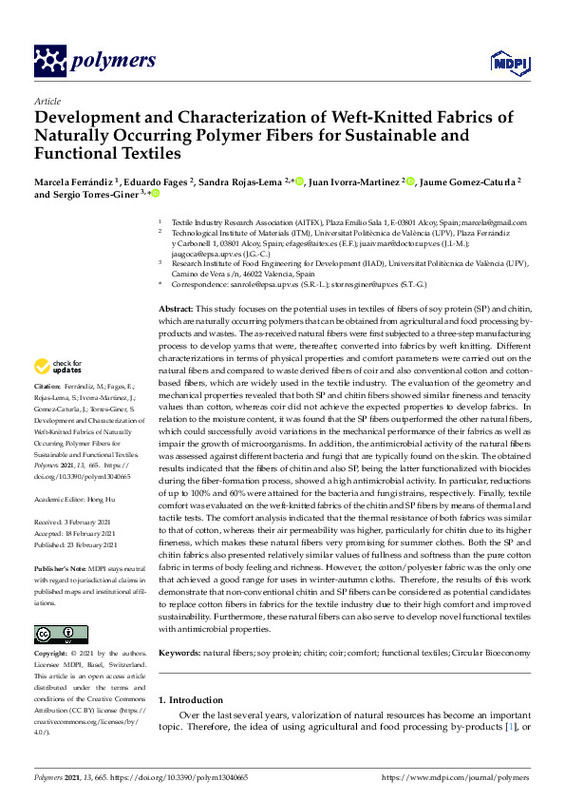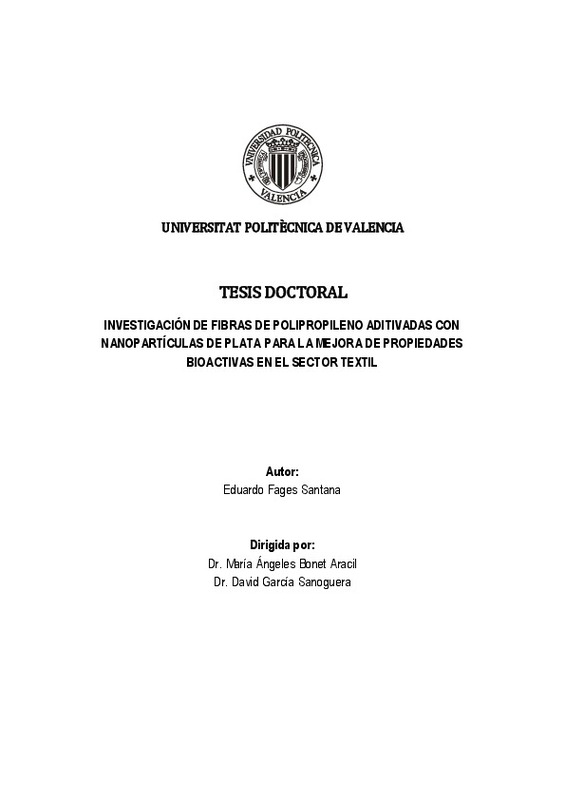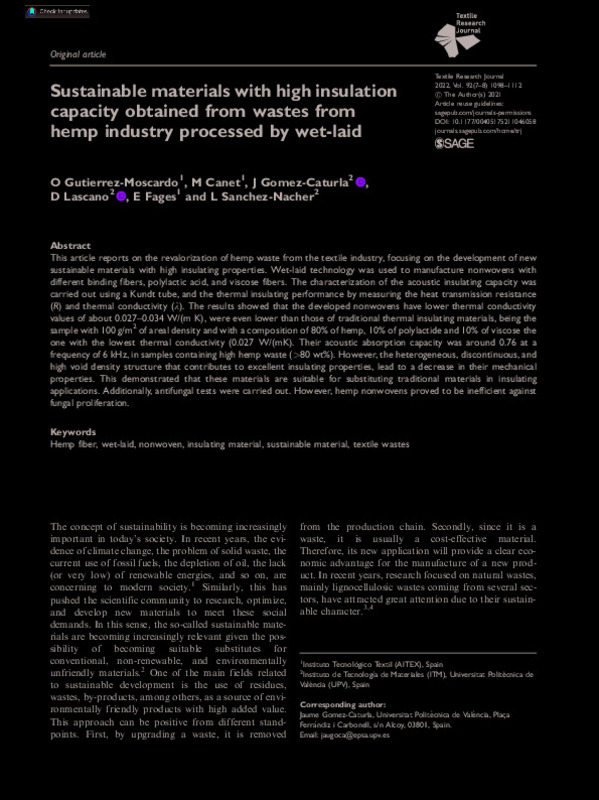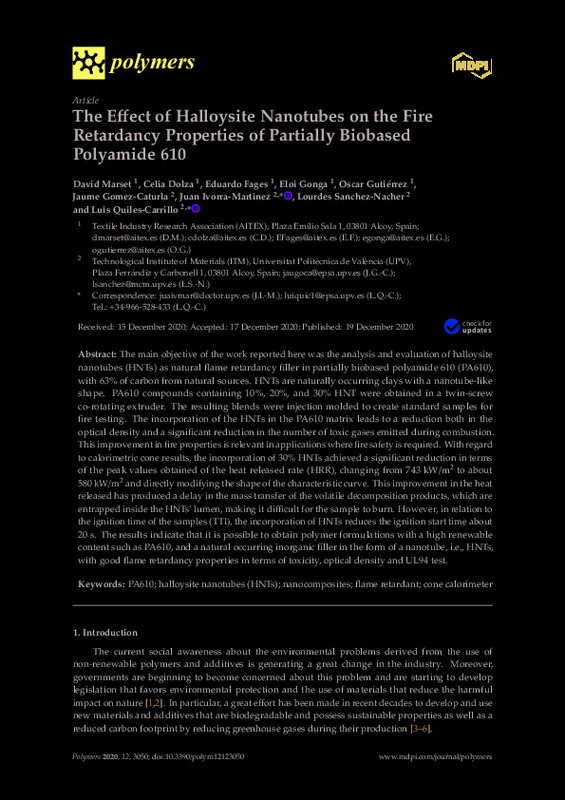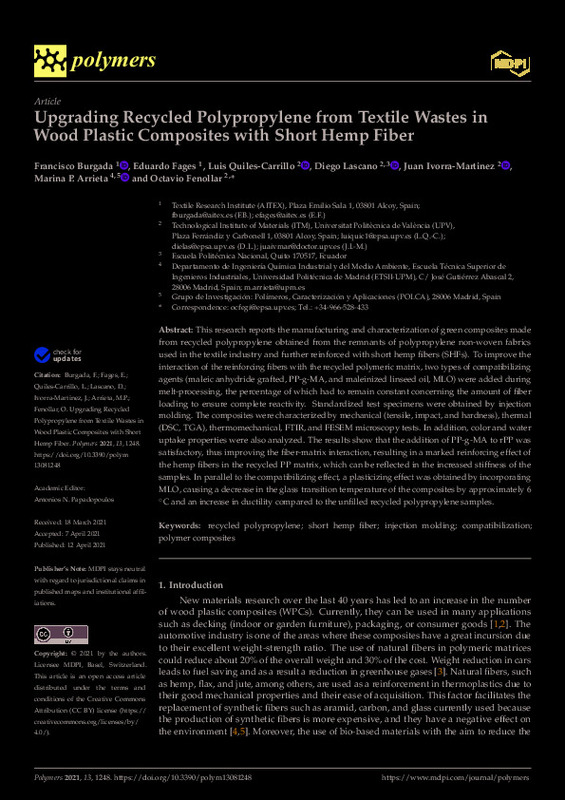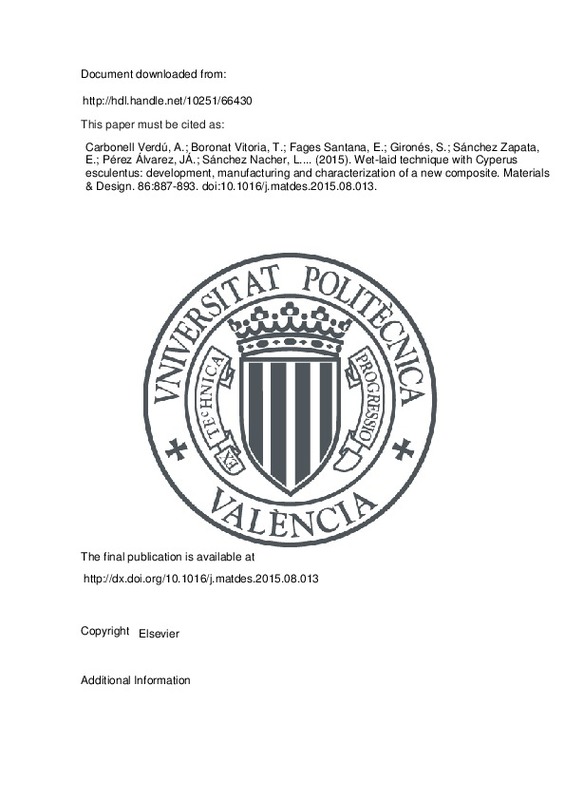

Listar por autor "Fages Santana, Eduardo"
RiuNet: Repositorio Institucional de la Universidad Politécnica de Valencia
- RiuNet repositorio UPV
- :
- Listar por autor
JavaScript is disabled for your browser. Some features of this site may not work without it.
Buscar en RiuNet
Listar
Mi cuenta
Ayuda RiuNet
Admin. UPV
Listar por autor "Fages Santana, Eduardo"
Mostrando ítems 1-14 de 14
-
Sempere Jaén, Francisco (Universitat Politècnica de València, 2019-10-29)[ES] Con la ejecución de este trabajo final de master se pretende obtener no-tejidos a partir de residuos textiles tales como borra textil larga, residuo de fibra de aramida o poliéster. Previamente se describirán las ...
-
Gutierrez, O.; Balart, Rafael; Lascano-Aimacaña, Diego Sebastián; Quiles-Carrillo, Luis; Fages, E.; Sanchez-Nacher, Lourdes (Springer-Verlag, 2020-05)[EN] This work is focused on the upgrading olive oil pomace to obtain high environmentally friendly insulation materials for the construction and building industry. Upgrading of these wastes has been carried out by using ...
-
Dolza, Celia; Fages, Eduardo; Gonga, Eloi; Gómez-Caturla, Jaume; Balart, Rafael; Quiles-Carrillo, Luis (MDPI AG, 2021-06)[EN] Environmentally friendly wood plastic composites (WPC) with biobased high density polyethylene (BioHDPE) as the polymer matrix and hemp, flax and jute short fibers as natural reinforcements, were melt-compounded using ...
-
Ferrándiz, Marcela; Fages, Eduardo; Rojas-Lema, Sandra Paola; Ivorra-Martinez, Juan; Gomez-Caturla, Jaume; Torres-Giner, Sergio (MDPI AG, 2021-02)[EN] This study focuses on the potential uses in textiles of fibers of soy protein (SP) and chitin, which are naturally occurring polymers that can be obtained from agricultural and food processing by-products and wastes. ...
-
Sáez Reviriego, Eva (Universitat Politècnica de València, 2016-10-28)[ES] En este trabajo se desarrollará un estudio del efecto del envejecimiento de pigmentos termocrómicos comerciales basados en microencapsulación, incorporados a resinas epoxi. El envejecimiento se llevará a cabo mediante ...
-
Dolza, Celia; Gonga, Eloi; Fages, Eduardo; Tejada-Oliveros, Ramón; Balart, Rafael; Quiles-Carrillo, Luis (MDPI AG, 2022-05)[EN] In this work, green composites have been developed and characterized using a bio-based poly-meric matrix such as BioPBSA and the introduction of a 30 wt.% short hemp fibers as a natural reinforcement to obtain materials ...
-
Fages Santana, Eduardo (Universitat Politècnica de València, 2013-02-14)El presente y el futuro de la industria textil están íntimamente ligados al concepto de textil técnico, artículos éstos concebidos para su aplicación en diferentes segmentos de mercado: salud y ámbito hospitalario, industria ...
-
España, J.M.; Samper Madrigal, María Dolores; Fages Santana, Eduardo; Sánchez-Nacher, Lourdes; Balart Gimeno, Rafael Antonio (Wiley-Blackwell, 2013-03)[EN] In recent years, it has been detected an increased interest in the development of materials from renewable resources. This trend has been intensified in the industrial sector where significant efforts have been made ...
-
Rojas-Lema, Sandra; Terol, Jorge; Fages, Eduardo; Balart, Rafael; Quiles-Carrillo, Luis; Prieto, Cristina; Torres-Giner, Sergio (MDPI AG, 2020-09)[EN] Copper(II) sulfate-loaded chitosan microparticles were herein prepared using ionic cross-linking with sodium tripolyphosphate (STPP) followed by spray drying. The microencapsulation process was optimal using an inlet ...
-
Gutiérrez-Moscardó, Ó.; Canet, M.; Gómez-Caturla, Jaume; Lascano-Aimacaña, Diego Sebastián; Fages, E.; Sanchez-Nacher, Lourdes (SAGE Publications, 2022-04)[EN] This article reports on the revalorization of hemp waste from the textile industry, focusing on the development of new sustainable materials with high insulating properties. Wet-laid technology was used to manufacture ...
-
Marset, David; Dolza, Celia; Fages, Eduardo; Gonga, Eloi; Gutiérrez, Óscar; Gómez-Caturla, Jaume; Ivorra-Martínez, Juan; Sanchez-Nacher, Lourdes; Quiles-Carrillo, Luis (MDPI AG, 2020-12)[EN] The main objective of the work reported here was the analysis and evaluation of halloysite nanotubes (HNTs) as natural flame retardancy filler in partially biobased polyamide 610 (PA610), with 63% of carbon from natural ...
-
Dolçà, Celia; Fages, Eduardo; Gonga, Eloi; Garcia-Sanoguera, David; Balart, Rafael; Quiles-Carrillo, Luis (MDPI AG, 2022-01)[EN] Biobased HDPE (bioHDPE) was melt-compounded with different percentages (2.5 to 40.0 wt.%) of short hemp fibers (HF) as a natural reinforcement to obtain environmentally friendly wood plastic composites (WPC). These ...
-
Burgada, Francisco; Fages, Eduardo; Quiles-Carrillo, Luis; Lascano-Aimacaña, Diego Sebastián; Ivorra-Martinez, Juan; Arrieta, Marina P.; Fenollar, Octavio (MDPI AG, 2021-04)[EN] This research reports the manufacturing and characterization of green composites made from recycled polypropylene obtained from the remnants of polypropylene non-woven fabrics used in the textile industry and further ...
-
Carbonell Verdú, Alfredo; Boronat Vitoria, Teodomiro; Fages Santana, Eduardo; Gironés, Sagrario; Sánchez Zapata, E.; Pérez Álvarez, José Ángel; Sánchez Nacher, Lourdes; García Sanoguera, David (Elsevier, 2015-12-05)Biobased composites were fabricated with waste of tiger nut natural fibers, different binder fibers (lyocell and cotton) and thermo-bonding fibers (PLA, HDPE, PA6-CoPA). These composites were processed by wet-laid process ...
Mostrando ítems 1-14 de 14

Universitat Politècnica de València. Unidad de Documentación Científica de la Biblioteca (+34) 96 387 70 85 · RiuNet@bib.upv.es





